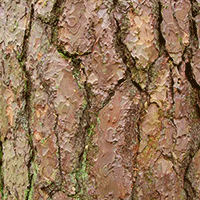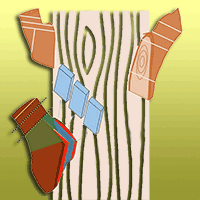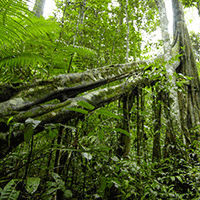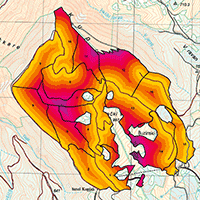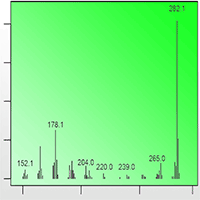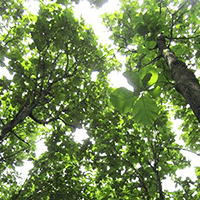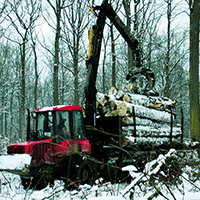
Life cycle assessment of tannin extraction from spruce bark
Tianran Ding (1-3), Sauro Bianchi (2), Christelle Ganne-Chédeville (2), Petri Kilpeläinen (1), Antti Haapala (3), Tarmo Räty (1)
iForest - Biogeosciences and Forestry, Volume 10, Issue 5, Pages 807-814 (2017)
doi: https://doi.org/10.3832/ifor2342-010
Published: Sep 25, 2017 - Copyright © 2017 SISEF
Research Articles
Collection/Special Issue: COST action FP1407
Understanding wood modification through an integrated scientific and environmental impact approach
Guest Editors: Giacomo Goli, Andreja Kutnar, Dennis Jones, Dick Sandberg
Abstract
Tannins have shown antifungal effects and have been considered a potential natural compound for wood preservation. Extracts produced from softwood bark contain both tannins and non-tannin compounds, which may reduce the effectiveness of tannin used as a wood preservative. The purpose of this research is to study the environmental impact of hot water extraction, identify the hot spots within the tannin cradle-to-gate life cycle and give suggestions to optimize its environmental profile. Different extraction and post-extraction scenarios of tannin production are compared using the life-cycle assessment method. Experiments were designed to study the tannin yield under different extraction scenarios; the post-extraction scenario analysis was based on literature review. The results show that the extract drying process is the primary contributor to the environmental impact of tannin production. Both preliminary cold water extraction and ultrafiltration after extraction are beneficial as they have fewer non-tannin compounds in the final products; however, preliminary cold water extraction had a considerably lower environmental performance. Successive extractions using fresh water at each cycle increased the total tannin yield, but increased the environmental burden. Using only evaporation to obtain a desired tannin concentration is not environmentally efficient. This paper provides a quantified environmental analysis for the development of tannin-treated wood products and discusses the different tannin extraction scenarios from an environmental point of view.
Keywords
LCA, Tannin, Spruce Bark, Hot Water Extraction, Evaporation, Spray Drying, Ultrafiltration, Preservative
Authors’ Info
Authors’ address
Petri Kilpeläinen
Tarmo Räty
Natural Resources Institute Finland - Luke, Helsinki (Finland)
Christelle Ganne-Chédeville
Bern University of Applied Sciences, Institute for Materials and Wood Technology, Biel (Switzerland)
Antti Haapala
University of Eastern Finland, School of Forestry, PO Box 111, 80101 Joensuu (Finland)
Corresponding author
Paper Info
Citation
Ding T, Bianchi S, Ganne-Chédeville C, Kilpeläinen P, Haapala A, Räty T (2017). Life cycle assessment of tannin extraction from spruce bark. iForest 10: 807-814. - doi: 10.3832/ifor2342-010
Academic Editor
Giacomo Goli
Paper history
Received: Jan 02, 2017
Accepted: Jun 13, 2017
First online: Sep 25, 2017
Publication Date: Oct 31, 2017
Publication Time: 3.47 months
Copyright Information
© SISEF - The Italian Society of Silviculture and Forest Ecology 2017
Open Access
This article is distributed under the terms of the Creative Commons Attribution-Non Commercial 4.0 International (https://creativecommons.org/licenses/by-nc/4.0/), which permits unrestricted use, distribution, and reproduction in any medium, provided you give appropriate credit to the original author(s) and the source, provide a link to the Creative Commons license, and indicate if changes were made.
Web Metrics
Breakdown by View Type
Article Usage
Total Article Views: 55801
(from publication date up to now)
Breakdown by View Type
HTML Page Views: 43261
Abstract Page Views: 5334
PDF Downloads: 5942
Citation/Reference Downloads: 37
XML Downloads: 1227
Web Metrics
Days since publication: 3027
Overall contacts: 55801
Avg. contacts per week: 129.04
Citation Metrics
Article Citations
Article citations are based on data periodically collected from the Clarivate Web of Science web site
(last update: Mar 2025)
Total number of cites (since 2017): 31
Average cites per year: 3.44
Publication Metrics
by Dimensions ©
Articles citing this article
List of the papers citing this article based on CrossRef Cited-by.
References
Flux behaviour and energy consumption of ultrafiltration (UF) process of milk. Australian Journal of Agricultural Engineering 1 (2): 54-65.
Gscholar
Sustainability of construction works. Environmental product declarations. Core rules for the product category of construction products. SFS-EN 15804 + A1, Finnish Standards Association, Helsinki, Finland, pp. 97.
Gscholar
Eucalyptus and leguminosae, Part 01: Acacia mearnsii. Eucalyptus Online Book and Newsletter 14 (2008): 13.
Gscholar
Grundlagen für Ökoprofile und Ökobilanzen in der Forst- und Holzwirtschaft [Introduction to Ecoprofiles and Life Cycle Assessment in Forestry and Timber Management]. Fraunhofer IRB Verlag, Hamburg, pp. 168. [in German]
Gscholar
Studies of grinding of wood and bark-wood mixtures with the szego mill. PhD thesis, University of Toronto, Canada, pp. 182.
Gscholar
Environmental management - Life cycle assessment - Principles and framework. International Organisation for Standardization, Geneva, Switzerland, pp. 20.
Gscholar
Environmental management - Life cycle assessment - Requirements and guidelines. International Organisation for Standardization, Geneva, Switzerland, pp. 46.
Gscholar
Tannine als Bindemittel für Holzwerkstoffe [Tannins as binders for wood materials]. Holz-Zentralblatt 120 (6): 90-93. [in German]
Gscholar
Gerbereichemie und Gerbereitechnologie [Tannin Chemistry and Tannin Technology] (3rd edn). Akademie-Verlag, Berlin, Germany, pp. 948. [in German]
Gscholar
Environmental friendly wood preservative system based on polymerized tannin resin-boric acid for outdoor applications. Ciencia y Tecnologia 12 (3): 253-257.
Gscholar
Pressurized hot water extraction and processing. In: “Enhancing Extraction Processes in the Food Industry” (Lebovka N, Vorobiev E, Chemat F eds). CRC Press, Boca Raton, FL, USA, pp. 223-254.
Gscholar
Concentration, dehydration, and drying. In: “Energy Efficiency and Management in Food Processing Facilities”. CRC press, Boca Raton, FL, USA, pp. 218.
Gscholar

